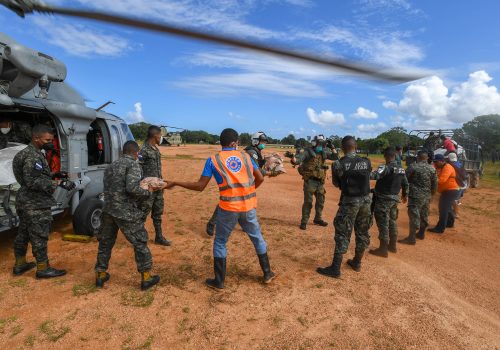Why the Inter-American Development Bank-World Bank deal matters, and what’s next
Insanity, the saying goes, is doing the same thing over and over and expecting a different result. With Latin America and the Caribbean (LAC) currently projected to grow at just 1.9 percent this year and 2.2 percent next year, the lowest of any developing regions except war-battered Emerging and Developing Europe, a new playbook is urgently needed. That message is clearly resonating with the new heads of the World Bank and the Inter-American Development Bank (IDB)—two development institutions critical to LAC’s future prosperity—who are answering the call to find a new, more impactful way of doing business in the region.
Their actions come as climate shocks and food insecurity have compounded structural economic vulnerabilities such as mediocre growth, inequality, and low productivity. With development needs expanding and evolving across the region, development finance organizations—and multilateral development banks (MDBs) at large—have a challenge in finding how to work better in LAC.
In this context, the historic IDB-World Bank partnership agreement signed by IDB President Ilan Goldfajn and World Bank President Ajay Banga on August 31 is a significant step in the right direction. At the signing ceremony in Washington DC, the leaders outlined three reasons for their collaboration: to elevate scale, improve impact, and join forces to meet increasingly complex challenges.
What the deal does
This agreement is a breakthrough for several reasons. First, it reflects an up-to-date understanding of the “unmet . . . modern-day challenges” facing the world, consistent with those outlined by US Secretary of the Treasury Janet Yellen in April 2022 at the Atlantic Council. Its three priorities—sustainable and inclusive development in the Amazon, climate resilience in the Caribbean, and digitalization, with special attention to education—focus on key areas of convergence between demand (client countries’ needs) and supply (donor interests, as well as World Bank and IDB product offerings).
In particular, the first two priorities exemplify the cross-border nature of today’s development challenges. As the COVID-19 pandemic made clear, tackling these challenges requires the provision of more and better regional and global public goods, and implicitly, smart alterations to the country-based approaches currently adopted by national governments and the MDBs’ lending models. The MDBs must play a greater-than-ever role in facilitating cooperation, aligning incentives, and boosting broader integration among countries.
Second, the agreement is expected to scale development financing and impact. Both institutions have historically provided sizable support to LAC countries, both as countercyclical lenders during crisis moments and steadfast drivers of long-term prosperity. In fiscal year 2022, their sovereign and private-sector operations combined for more than $40 billion in commitments in LAC. But much more is needed. Financing climate and nature-related efforts alone entails the multiplication of resources “from billions to trillions,” as Goldfajn explained last month.
Given the lengthy process for securing the necessary financial and political commitment to a MDB capital increase, optimal use of existing funding will be essential. The agreement is welcome news in this regard. While the two organizations have co-financed and collaborated in many one-off projects in the past, a standing coordination mechanism to systematically incentivize deep convergence and build trust was absent and long overdue. Now more than ever, the IDB and World Bank teams will be encouraged to synergize specific operations and comparative strengths—not only financial but technical and sectoral—and reduce duplication.
The external coordination efforts between the World Bank and IDB should be complemented and strengthened by their own internal enhancements to maximize impact. These internal measures could include balance-sheet optimizations outlined in the Group of Twenty (G20) capital adequacy framework and enhancing the quality, effectiveness, and measurement of development operations. They might also include a growing emphasis on climate and better serving low-income and vulnerable pockets of middle-income countries. Moreover, additional recommendations could include those proposed by the Atlantic Council’s Bretton Woods 2.0 Project on MDB governance.
Third, the agreement signals top-level buy-in by both the IDB and World Bank, as well as continued momentum from the historic visit of Goldfajn and Banga to Jamaica and Peru in June. This joint tour, the first ever by the organizations’ presidents, kicked off technical discussions around collaboration. The process then impressively moved through both organizations’ respective bureaucracies in just over two months.
The work ahead
The milestone of this agreement should not be cause for complacency. The unwavering commitment by both organizations’ leadership and diligent staff-level follow-up will remain vital to the successful implementation of the project, and to ensuring that it produces concrete, measurable results. It will be important to assess in two years—halfway through the agreement’s execution period—the degree to which the collaboration has improved the scale and impact of the institutions’ financing and technical support in the three target areas. Going forward, one additional success metric and legacy that this agreement could bring about is the proliferation of similarly meaningful collaboration deals with or among new participants, such as the International Monetary Fund, CAF-Development Bank of Latin America and the Caribbean, the Climate Investment Fund, and the Pan American Health Organization
Finally, the agreement represents a call to action for the broader development community beyond the multilateral organizations. For example, the suggested collaboration between the Multilateral Investment Guarantee Agency (the World Bank’s political risk insurance arm) and IDB Invest (the IDB Group’s private-sector arm) is a nod to the growing importance of unlocking development through private sector financing and expertise. It also speaks to the potential for borrowing countries to better partner with and crowd in the private sector, by leveraging MDBs’ unique financial and operational instruments and their role as an honest broker. In general, borrowing countries will do well to continue providing input to inform the IDB-World Bank collaboration.
This new partnership and its underlying efforts also deserve the attention of donor countries. For the United States, which is by far the largest shareholder and home to both organizations’ headquarters, the agreement should serve as three reminders. First, there are high-impact development opportunities through which to invest and engage LAC. Second, it is not by chance that this historic agreement materialized in LAC before other regions. Despite its own development challenges, LAC is a useful source and testing ground of innovative solutions to some of the world’s most pressing challenges. Third, by driving socioeconomic progress in the developing world through projects with high standards, impact, and transparency, institutions such as the IDB and World Bank also indirectly advance a rules-based order that seeks to directly improve peoples’ lives. For comparison, at more than $40 billion in fiscal year 2022, the World Bank and IDB’s combined commitments in LAC represented more than five times the US International Development Finance Corporation’s $7.4 billion global commitments during the same period.
Amid ongoing geopolitical fragmentation and development challenges, empowering the collaboration between multilateral organizations such as the World Bank and the IDB is a hopeful sign of what is possible. It shows how longstanding institutions can begin to modernize to catalyze their own future effectiveness and broader global prosperity. The next challenge, as always, is to transform the ambition into reality.
Jason Marczak is senior director of the Atlantic Council’s Adrienne Arsht Latin America Center. He tweets at @jmarczak.
Pepe Zhang is a senior fellow at the Adrienne Arsht Latin America Center. He tweets at @pepe_zhang.
Further reading
Mon, Mar 20, 2023
Humanitarian aid: Defining new areas of US-LAC collaboration
Report By Pepe Zhang, Isabel Bernhard
The US humanitarian assistance and disaster relief (HADR) system—well practiced and extensively developed—could further serve US and partners’ needs in Latin America and the Caribbean (LAC) and beyond through targeted improvements. Based on our experience as HADR practitioners with operational and academic expertise, we share insights from many years of working with partners in the Americas.
Tue, Mar 21, 2023
An imperative for women’s political leadership: Lessons from Brazil
Report By Valentina Sader, Isabel Bernhard
Women are essential to democracy, yet face systematic barriers to political entry and impact. Using the case of Brazil, we analyze the state of women’s political participation and of political violence against women. We propose timely, actionable approaches to reduce women’s unique political challenges and to further strengthen democratic health.
Mon, Jun 26, 2023
Unlocking economic development in Latin America and the Caribbean: Five opportunities for private-sector leadership and partnership
Report By Pepe Zhang
To sustain the ongoing recovery against short-term headwinds and boost inclusive, productive, and sustainable development in the long term, governments cannot, and should not, act alone. In this context, the Atlantic Council is providing timelier-than-ever insights to highlight the critical role of the private sector in supporting growth and improving lives in Latin America and the Caribbean.
Image: Inter-American Development Bank President Ilan Goldfajn and World Bank President Ajay Banga sign an agreement on August 31, 2023. Photograph courtesy of the the Inter-American Development Bank.


